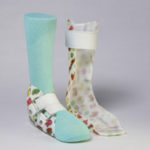 Australian researchers found no correlation between body mass index and prevalence of pediatric flatfoot, but used a different methodology than previous studies that reached an opposite conclusion. The conflicting results have revitalized the ongoing debate on this topic.
Australian researchers found no correlation between body mass index and prevalence of pediatric flatfoot, but used a different methodology than previous studies that reached an opposite conclusion. The conflicting results have revitalized the ongoing debate on this topic.
By Cary Groner
Over the years, researchers have claimed to discover significant correlations between childhood obesity and pediatric flatfoot. One well-known study by Pfeiffer et al, for example, examined 835 children aged 3 to 6 years and concluded that flatfoot prevalence was influenced by three factors: age (flatfoot was more common in younger children), gender (boys had a higher prevalence), and weight (42% of normal-weight kids had flat feet vs 51% and 62% of those who were overweight and obese, respectively).1 Other studies have reached similar conclusions.
Recent research has called such findings into question, however, and resurrected the controversy about which children should be treated. In a paper presented at the 2013 Australasian Podiatry Council Conference in Sydney last June2 and currently in press with the Journal of Foot and Ankle Research, Angela Evans, PhD, examined body mass index (BMI) and foot posture index (FPI) scores for 698 children and found no correlation between BMI and flatfoot prevalence. The work expanded on an earlier study reporting similar findings in 140 children.3
“These studies conflict with previous studies that found a correlation, even though intuitively that correlation makes sense,” acknowledged Evans, who has a private practice in Adelaide, Australia, and a research position at La Trobe University in Melbourne. “Part of the problem may be that most of those studies used a footprint-based method of assessing foot posture.”
Footprint measures raise an obvious question in the case of obese children: are the feet flatter or merely fatter? That is, when more adipose tissue is compressed under the child’s weight, does this merely create the impression of a flatter foot? The question has provoked significant debate—not only regarding the value of different assessment methods, but also in terms of its clinical implications.
The evidence
The evidence supporting the link between weight and flatfoot isn’t copious, but much of it seems plausible enough. For example, in a paper that appeared in 2006 in the journal Obesity, Australian researchers compared the feet of 19 overweight or obese preschool children with those of 19 controls matched for age, height, and sex. They concluded that there was no difference between groups in the thickness of the midfoot plantar fat pad, which was measured with ultrasound. But the heavier kids had a significantly lower plantar arch height, assessed via plantar footprints.4 Although footprints themselves may not offer a particularly robust evaluation tool, when the fat pad variable is accounted for, they seem more persuasive—or might, perhaps, in a larger sample size.
Another small study, this one from the US, reported similar findings in 2012, noting that obese children had less ankle dorsiflexion, resulting in longer foot contact time during stance, as well as significantly more flexible feet and greater arch drop.5
Some studies have been done in older children, which can complicate the comparison of results because their feet have had more time to develop. Nevertheless, a 2007 study of 200 Scottish children aged 9 to 12 years reported that foot length and width were greater, while navicular height was lower, in the heavier children.6 And a 2009 study from Spain evaluated foot arch types in 58 obese youths aged 9 to 16.5 years using both footprints and lateral weight-bearing radiographs, compared to the same number of normal-weight controls. Both measures found a lowering of the medial longitudinal arch in the obese children.7
A particularly interesting study was conducted in Spain and published in the European Journal of Pediatrics last year.8 Researchers used a 3D digital scanner to evaluate the foot morphology of 1032 schoolchildren aged 6 to 12 years, and reported that the arches of the obese children didn’t develop as fast as those of the normal-weight kids. A closer look at the reported data reveals odd contradictions, however. For example, the arch height of normal-weight children increased at an annual rate of 4.8%, whereas for obese children the rate was 3.7%. That fits the pattern; however, the rate for overweight kids, who were assessed separately from the obese ones, had a rate of 6.1%—higher than that of the normal-weight children.
Measurements
Clinicians and researchers can be forgiven for scratching their heads when faced with such data. Many now tend to draw conclusions tentatively, if at all. Angela Evans’s papers provide an example of how quickly things can shift, in fact.
In terms of her own research, she attributes the change of perspective to use of the FPI.
“The difference in our study that really stood out was the way we assessed foot posture,” she said. “We know that the FPI is fairly reliable; it has tested validity and is widely used clinically. So when we found these differences [vs previous research], we wondered what was going on. Our first study was small, but in the second one we got the same results in about seven hundred kids. There was not an association between increasing body mass and the rate of flat feet when measured by the FPI.”
Evans doubts the validity of footprint-based evaluations, and notes that even radiographic findings are problematic because there aren’t a lot of normative data to compare them with (not to mention the ethical issues that would be associated with subjecting schoolchildren to mass x-ray screening to gather those data).
But how about the FPI itself? Is it a valid assessment tool in obese children?
Anthony Redmond, MD, a researcher at the University of Leeds in the UK, who was largely responsible for developing and validating the FPI, told LER via email that it was originally designed as a measure for pediatric foot posture and was carefully validated in that role.9
“Re: childhood obesity, that is a different story altogether,” Redmond wrote. “[There are] problems with the use of footprint measures…and to some degree the same applies to the FPI and to any external measures of foot posture. Where the research question relates specifically to obesity, in my view the only valid measures of posture/alignment will be those that use internal imaging to visualise bone alignment directly.” Examples of such imaging modalities would include x-ray, magnetic resonance imaging, computed tomography, or radiostereometric analysis.
“I don’t think technically I absolutely agree,” Evans responded, when read this email. “The point is that the different measures have shown conflicting results. The FPI is widely used by clinicians, and I don’t think they have any sense of it being restricted regarding the incidence of childhood obesity.”
Clinical implications
Better clinical practice is, after all, the main point of sorting out such matters.
“Childhood obesity is terribly concerning from a wider health perspective,” Evans continued. “How much we need to worry about its relationship to foot posture is still undetermined, however, and I’m concerned that overdiagnosis may lead to unnecessary intervention.”
In the experience of Alan Ng, DPM, who practices with Advanced Orthopedics and Sports Medicine Specialists in Denver, CO, pediatric flatfoot has more to do with genetics than overweight.
“I lean toward agreeing with Evans on this issue, because in the kids I see, biomechanics are primarily based on genetics,” he said. “Later in life, if they maintain an elevated BMI, they may develop flatfoot secondary to overload and posterior tibial tendon dysfunction. But at that early stage, I don’t think childhood obesity really leads to flatfoot.”
Regardless of the patient’s weight, Ng decides whether to treat based on symptoms—and not just pain.
“If they come in complaining of tripping, or that they get too fatigued doing athletics at school, we assess them,” he said.
High on his list is checking for a secondary accessory ossicle or an os tibiale externum on the medial aspect of the navicular.
“They can have symptoms when they have a connection between that bone and the navicular, and the area gets irritated,” he explained.
Edwin Harris, DPM, associate professor of orthopedics and rehabilitation at Loyola University Medical Center in Maywood, IL, concurred with Ng about obesity and flatfoot.
“I tend to agree with the conclusions that increased BMI probably doesn’t correlate with pronated feet,” he said. “My patients include just as many skinny kids as obese kids, though it is harder to manage obese kids with orthotic devices.”
Harris pointed out that most of the literature relating BMI and flatfoot focus on arch height—which, as noted, is difficult to quantify clinically.
“There are no proven ways of measuring it unless you do it radiographically,” he said. “People say they’re going to measure the distance between the navicular and the floor, but I’m not sure how precise that measurement is, or whether I could duplicate it, due to all the variables.”
Harris also noted that researchers and clinicians are working without a particularly good definition of what constitutes flatfoot.
“It’s really a three-plane deformity, but most of the articles look at it only in the sagittal plane,” he explained. “That’s not really a good indicator of what’s going on.”
He, too, limits his treatment to those with symptoms, including pain in the arch.
“Pronated feet have a whole slew of morbidities other than obesity,” he said. “Some children are hypotonic or have other risk factors for muscle imbalance. But when they complain of pain, I listen to them and look at them carefully.”
Russell Volpe, DPM, who practices in Manhattan and is a professor of orthopedics and pediatrics at the New York College of Podiatric Medicine, said that the relationship between obesity and pediatric flatfoot is more complicated than simple cause and effect.
“Inactivity contributes to obesity, so we want to keep kids as active as possible,” he said. “From the podiatric perspective, if they have flatter, more pronated feet, and if that contributes to inactivity, then we have a vicious cycle that might lead to significant disability and worsening of obesity over time, which would be well worth avoiding.”
Asked whether only symptomatic children would likely curtain their activities, however, Volpe dissented.
“I’m not ready to concede that only symptomatic kids become less active,” he said. “There is such a thing as a presymptomatic child, and those of us treating children with flat feet need to be mindful of that. When we identify those, we need to do something to help them function better. Most of the time, when an older child or an adult comes to us with a mechanical foot problem, it’s been years in the making.”
Volpe considers BMI just one among a host of factors that help determine a clinical pathway.
“No kid is going to be in or out of the treatment group just because they’re heavy,” he said. “Obesity is interesting from a research, screening, and risk standpoint, but I’m not going to be the one saying, ‘Give all the fat kids orthotics.’ It’s just one more thing on my list of reasons when I decide to intervene or not.”
Volpe noted, moreover, that much of the discussion about obesity and flatfoot has turned on measurement.
“Angela points out that the footprint method is flawed; she hangs her hat on the FPI having normative value, and I’ll give her that,” he said. “But Tony Redmond now seems to be saying that the FPI is not the be-all and end-all, either. That Angela’s studies haven’t found a correlation may also be a measurement flaw, though in fairness to her, she acknowledges that in her conclusion. I’d be hard-pressed as a scientist and an academic to dismiss her work; I think it’s worthy of our attention. But I think we need to look further; there’s probably a bigger and better study to be done to see if we can settle this definitively.”
More studies
As it happens, recent research has shed light on which patients with flexible flatfoot are most likely to become symptomatic. In a study conducted at Rady Children’s Hospital in San Diego, researchers looked retrospectively at 135 patients, 45 of whom were asymptomatic. As assessed by standing anteroposterio and lateral radiographs, the authors concluded that lateral displacement of the navicular seemed to be related to symptom onset.10
“This may be an area we look at more carefully in the future, and it may start to simplify this whole debate,” said Evans.
In the meantime, however, she and her colleagues are about to embark on further research at La Trobe. The study will compare footprint measures, FPI, and the results of external 3D digitized foot scanning to evaluate their relative strengths and weaknesses.
“We need to clarify this discordance,” she said. “We’re hoping that this independent 3D imaging will teach us more about both of those measures. It’s quite exciting.”
Cary Groner is a freelance writer in the San Francisco Bay Area.
1. Pfeiffer M, Kotz R, Ledl T, et al. Prevalence of flatfoot in preschool-aged children. Pediatrics 2006;118(2):634-639.
2. Evans A. The relationship between pediatric foot posture and body mass — do heavier kids really have flatter feet? J Foot Ankle Res 2013;6(Suppl 1):12.
3. Evans A. The paediatric flat foot and general anthropometry in 140 Australian schoolchildren aged 7-10 years. J Foot Ankle Res 2011;4(1):12.
4. Mickle KJ, Steele JR, Munro BJ. The feet of overweight and obese young children: are they flat or fat? Obesity 2006;14(11):1949-1953.
5. Shultz SP, Sitler MR, Tierney RT, et al. Consequences of pediatric obesity on the foot and ankle complex. J Am Podiatr Med Assoc 2012;102(1):5-12.
6. Morrison S, Dorward B, Watt G, Donaldson M. Anthropometric foot structure of prepubescent children with excessive versus normal body mass: a cross-sectional study. J Am Podiatr Med Assoc 2007;97(5):366-370.
7. Villarroya MA, Esquivel JM, Tomas C, et al. Assessment of the medial longitudinal arch in children and adolescents with obesity: footprints and radiographic study. Eur J Pediatr 2009;168(5):559-567.
8. Jimenez-Ormeno E, Aguado X, Delgado-Abellan L, et al. Foot morphology in normal-weight, overweight, and obese schoolchildren. Eur J Pediatr 2013;172(5):645-652.
9. Redmond A, Crane Y, Menz H. Normative values for the Foot Posture Index. J Foot Ankle Res 2008; 1(1):6.
10. Moraleda L, Mubarak S. Flexible flatfoot: differences in the relative alignment of each segment of the foot between symptomatic and asymptomatic patients. J Pediatr Orthop 2011;31(4):421-428.





